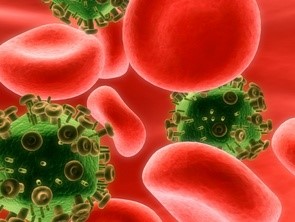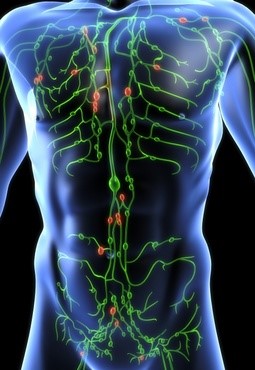

| Ljubav na djelu | 2014-08-21 |
LYMPHOMA
When cells from lymphoid families start to grow up, they move to other organs of the body, including the thymus gland, lymph nodes and other tissues. Malignant change in these mature cells and their uncontrolled multiplication resulting disease related to leukemia, malignant lymphoma (malignant lymphoma).
Lymphomas, in contrast to leukemia, belong to the category of solid tumors, that are restricted to the tissue. Lymphoma can develop slowly or be aggressive.
We split it into two basic, and very different groups:
A special type of lymphoid malignancy refers to the mature form of B lymphocytes, antibody producing cells, and are called plasma cells. This disease is called multiple myeloma (multiple myeloma).
 Diagnosis of the disease Hogdkin's diseas:
Diagnosis of the disease Hogdkin's diseas:
Be sure to see your doctor if the following symptoms occur more than two weeks : painless swelling of the lymph nodes in the neck , groin or armpits , fever , fatigue , weight loss and itchy skin . If there are symptoms , the doctor will carefully check the existence of a swelling in the neck , groin and armpits .
If a person has to pathological changes in the lymph nodes , one of the nodes are surgically removed in order to confirm the diagnosis . Lymph node is sent to a laboratory for analysis , which determines the shape and gives a diagnosis of lymphoma . Carried out other tests - CT of the chest , abdomen and pelvis , bone marrow puncture , bone biopsy and blood tests - to determine to what degree the disease is .
Forecasts for the recovery and treatment depend on the degree of spread of lymphoma ( whether it is localized or metastatic ) , size of swell areas , the results of blood tests , the symptoms type and patient age, gender and general health.
What are the possible treatments?
The treatment is an option for people suffering from Hodgkin's disease. Here are two possible forms of treatment:

( relapse), treatment that is applied in the past and the health of the patient .
If the first occurrence of disease applied radiotherapy, but not chemotherapy, the disease can be re-administered chemotherapy. If this is more of chemotherapy (without radiotherapy), and the tumor is only returned to the lymph nodes, applies radiation of the lymph nodes, with or without chemotherapy. If the disease returns in more parts of the body simultaneously, the patient is referred to chemotherapy. In some centers conduct clinical studies involving treatment with high doses chemotherapy in combination with bone marrow transplantation or peripheral blood stem cells.
Non- Hodgkin's Lymphoma
Non - Hodgkin's lymphoma ( non - Hodgkin , NHL ) is a tumor that arises malignant transformation lymphocyte cell line . Understanding the NHL last decade greatly improved with the new , all successful ways of treating changing prognosis of patients with this disease .
Entitled non - Hodgkin's lymphoma , involves more than 30 types of lymphoma , which differ by the type of cell in which they are incurred , growth rate, sensitivity to treatment and prognosis
According to malignancy - growth rate can be divided into non - Hodgkin's lymphoma of low, medium and high-grade malignancy .
Lymphomas low grade malignancy
Lymphomas of low grade malignancy characterized by slower growth and progress , causing patient symptoms usually noticed when the disease is already advanced. Lymphomas low grade malignancy are also called indolent lymphomas .
The best known representatives of this group are follicular lymphoma and small lymphocytic lymphoma ( or chronic lymphocytic leukemia ) . With some slow growing form of indolent lymphoma , depending on the judgment of the physician , treatment cannot be started immediately after diagnosis . Instead, patients are regularly reviewed , and treatment is started when the signs of the progression ( progression ) of the disease . However , healing in indolent NHL is usually not possible . Instead , treatment of the patient is introduced into remission , a state characterized by the disappearance of the symptoms and signs of cancer in the blood or bone marrow . Remission can be complete when the available diagnostic methods cannot detect signs of disease or partial ( partial ) when there are signs of the disease , but the patient has no symptoms and live almost normal lives . After remission , which may last for several years , the disease usually returns , observed diagnostic methods or reappearance of symptoms . Such a condition is called relapsing and it always requires treatment .
Lymphomas of high grade malignancy
High-grade malignant lymphomas grow very quickly , which is why very quickly produce symptoms . That is why it is often detected in early stages , when the disease has not progressed . Lymphomas of high grade malignancy has called aggressive lymphomas .
The best-known representatives of this group are diffuse and anaplastic large cell lymphoma of B - lymphoma and lymphoblastic lymphoma . Without treatment , aggressive lymphomas would very quickly lead to death , so the treatment must be started immediately after the diagnosis . Since these lymphomas usually respond very well to treatment , the treatment can be achieved not only long-term remission , but cure .
Medium- grade malignant lymphomas
Medium- grade malignant lymphomas at the speed of growth and malignancy between the two groups described above .
Non- Hodgkin's ( Non - Hodgkin's ) lymphoma - important to remember :
The low degree of malignancy:
Small lymphocytic (diffuse, well-differentiated lymphocytic) LYMPHOMA
A low degree of malignancy. The majority of patients did not require treatment through the first 3-4 years. Mean survival after diagnosis: 8-10 years.
Follicular GENERALLY small cleaved cells ( nodular poorly differentiated lymphocytic ) LYMPHOMA
A low degree of malignancy . This lymphoma is very common in this group of diseases and accounts for over half of all cases of non - Hodgkin's disease . Patients have increased , painless lymph nodes that are present for a long time and can increase and decrease . In some patients find a tumor in the abdominal cavity . Although patients as a sign of disease state only increase nodes , tests are usually found spread disease - in 80 % of patients affected by the liver, spleen and bone marrow . The course of the disease is very different . Most patients do not need any treatment in the first three years of the disease . In patients with limited I and II stage at diagnosis, radiation limited areas of the body heal some patients , and some leading to prolonged periods without symptoms . In patients with a higher prevalence of the disease after a while markedly dilated, and the first sign of the rapid growth of the lymph nodes . The pain caused by the rapid growth of the affected organs are reduced after administration of chemotherapy ( anti- cancer drugs - cytostatic ) . It is necessary to re- node biopsy because at this stage in 60% of patients possible transition to a more aggressive type of the disease . The transition to a more aggressive type of the disease is associated with a worse outcome of disease and poorer response to treatment .
The application of chemotherapy , 40-70 % of patients can heal and phase without signs of disease can last 2-3 years.
Patients with follicular lymphoma survive long after diagnosis : Median survival of patients with stage III or IV spread is 7-9 years .
Follicular, mixed small cleaved and large cell (nodular MIXED)
This type of lymphoma has features in common with the other two types of non-Hodgkin's lymphoma low grade malignancy. A low degree of malignancy. Patients with enlarged lymph nodes often have a tumor in her stomach. Good success in the treatment recommendations are to begin treatment immediately after diagnosis of the disease.
Middle grade malignancy:
Follicular GENERALLY large cell (nodular histiocytoma)
Build the affected lymph node is preserved. Less commonly affects the bone marrow and liver, but often report large tumor mass in the body and spread beyond the lymph nodes. At a later stage of the disease can cross the aggressive subtype of the disease and therefore it is necessary to start treatment on time. The experiences of treatment with chemotherapy are very encouraging.
DIFFUSE MIXED large cell (diffuse MIXED)
This is a subtype of lymphoma intermediate degree of malignancy, and if their behavior is similar to diffuse large cell lymphoma. It is treated with aggressive chemotherapy. The success of treatment varies with the individual patient.
The high degree of malignancy :
Lymphoblastic lymphoma ( lymphoblastic DIFFUSE )
Is the most common subtype of non - Hodgkin's disease , which occurs in children . Patients are usually men younger age , and the symptoms are enlargement of the lymph nodes and large tumor masses in the chest . This is the most common tumor mass greater than 10 cm in diameter and causing numerous disturbances due to pressure on the large blood vessels , heart and respiratory system . At the time of diagnosis the majority of patients with stage III or IV disease spread , and about half have symptoms . Patients in diagnosing diseases generally have affected the bone marrow , but later spread the disease in 60 % of patients indicating so . leukaemic phase and is then difficult to distinguish this lymphoma, acute leukemia . Involvement of the bone marrow is usually an introduction to the abstraction of the central nervous system ( brain, spinal cord and its nerves ) . The disease is treated with aggressive chemotherapy .
Burkitt's lymphoma
Burkitt's lymphoma is predominantly occurs in children or in adults up to 35 year of life . There are two main forms of the disease : African ( endemic ) type is gripping jaws to spread to the meninges and bone marrow , and the American ( non-endemic ) tumor mass in the abdominal cavity and spreading in the skin , bone and lymph nodes . It is treated with aggressive chemotherapy .